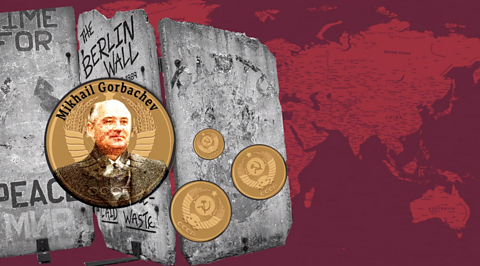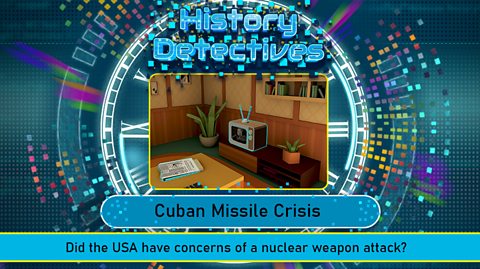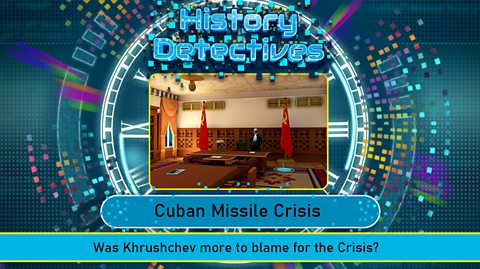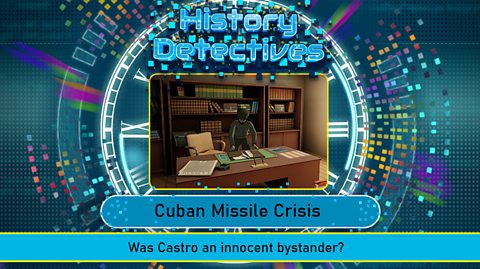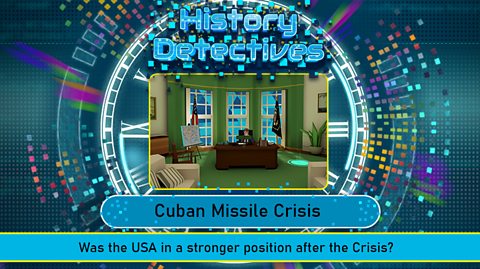Key points
- The Cuban Missile Crisis in 1962 was probably the nearest the Cold War came to breaking into an all-out nuclear war between America and the Soviet Union.
- Nuclear missile bases in Cuba posed a great threat to America, and the decisions taken by either side in October 1962 could have led to disaster.
Game - Cuban Missile Crisis
Play a History Detectives mission exploring how American citizens felt during the Cuban Missile Crisis.
You can also play the full game.
Key events in the Cuban Missile Crisis
What had happened in the Cold War by 1962?
The Cuban Missile Crisis happened one year after the construction of the Berlin Wall, which was a major source of Cold War tension in Europe.
The Cold War was still tense in other parts of the world, too. In Vietnam, America was increasing military presence to help South Vietnam in their fight against the communismA system of running a country in which all means of production such as tools, factories and raw materials, are owned by the community as a whole. Private property does not exist and each individual contributes according to their ability and receives according to their needs. This means there is no hierarchy of social class. North.
America and the Soviet Union were competing in the Space Race, trying to be the first country in the world to send a man to the moon and have the best space technology. In 1959, Russian cosmonaut Yuri Gagarin had become the first person to travel into space.
American President John F. Kennedy was under pressure to stand up to the communist Soviet Union. This would influence some of the decisions he took in dealing with the Cuban Missile Crisis.
Watch the video to find out about the causes of the Cuban Missile Crisis
Narrator: In 1959, Fidel Castro overthrew a corrupt right-wing dictatorship, and took power in Cuba. This was just 90 miles from Florida.
The Americans had many business interests in Cuba, and once in power, Castro nationalised American companies. In retaliation, the US stopped all aid to Cuba, and all imports of Cuban sugar. This was a huge blow, as sugar was the core of the Cuban economy. Castro asked the Soviet Union for help. They agreed to buy 1 million tonnes of Cuban sugar every year. Castro and Khrushchev were now trading partners. Castro became a communist.
America was alarmed. So in April 1961, the CIA trained, armed and transported 1300 Cuban exiles to invade Cuba. They landed at the Bay of Pigs, and tried to overthrow Castro. But they failed, and President Kennedy was humiliated.
After the Bay of Pigs, Castro asked the Soviets for weapons to defend Cuba against America. The Americans saw this agreement, and sent planes to photograph Cuba. They discovered the missile sites in October 1962. They put major American towns and cities within range of Soviet nuclear missiles.
America had already put nuclear missiles in Turkey, in firing distance of the USSR. President Kennedy called a meeting of the National Security Council, and went on TV to tell the American people that they were under threat.
President Kennedy: I call upon him further to abandon this course of world domination, and join in an historic effort to end the perilous arms race, and to transform the history of man.
Narrator: It was the start of a crisis that took the world to the brink of a nuclear holocaust.
Background to the Cuban Missile Crisis
Cuba is an island just 90 miles off the coast of Florida, in America. Until 1959, America had been their close ally, and they were one of the main consumers of Cuba’s sugar and tobacco.
In 1959, the undemocratic, corrupt Cuban government was overthrown in a communist revolution, led by Fidel Castro. He seized many American-owned businesses in Cuba and nationalisedAn industry or business being taken over by the government. them. He refused to pay America any compensationSomething awarded to someone in recognition of loss., meaning that America lost out on products and profits from these businesses.
In response, America stopped buying goods such as sugar from Cuba. The communist Soviet Union stepped in and agreed to buy large quantities of sugar from Cuba, building relations between the two countries.
The Bay of Pigs
In 1961, the newly elected American President John F. Kennedy approved a plan to invade Cuba and overthrow the communist regime. He gave permission for the CIACentral Intelligence Agency – a foreign intelligence service of the American government, created in 1947 to coordinate and conduct espionage (spying) and gather information about other countries. to launch the Bay of Pigs invasion.
This was a plan for Cuban exilesSomeone who is barred from their own country, often for political reasons or for punishment., who had left Cuba and fled to America following the revolution, to invade Cuba and overthrow Castro. The invasion would begin at the Bay of Pigs, on the southern coast of Cuba. They had support from the CIA but the US government did not send US troops to support the invasion.
The plan was a disaster. Upon arrival, they were met by heavily armed Cuban troops and they were all either captured or killed. The Cuban people did not give their support to the invasion either.
The invasion showed that America was prepared to take strong measures to remove communism from Cuba, but it pushed Fidel Castro to seek further support from the Soviet Union and their leader, Nikita Khrushchev. It was an embarrassing failure for Kennedy and the CIA. Kennedy had won the presidential election of 1960 by promising to be tough on communism and the Bay of Pigs failure was just three months into his presidency.
Game - Khrushchev
Play a History Detectives mission exploring Khrushchev's role in the Cuban Missile Crisis.
You can also play the full game.
Missiles on Cuba
On 14 October 1962, a U-2A plane that could fly at very high altitudes and take detailed photographs on the ground. This made it very useful for spying on enemy positions. spy plane flew over Cuba and photographed Soviet nuclear missile sites being constructed. This was a huge threat to America. Cuba was only 90 miles from the coast of Florida, meaning that many of the biggest US cities, like Washington DC and New York, would be well within range of these missiles. The government believed that the lives of 80 million Americans were in danger.
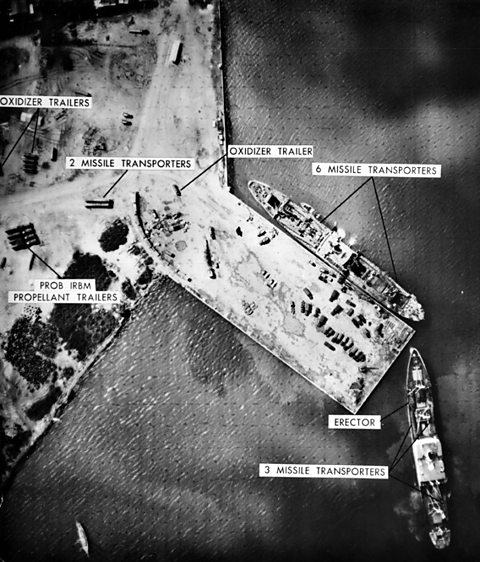
President Kennedy's options
President Kennedy initially kept this information secret from the American people while he and his advisors worked out what to do about the missiles. They considered several options:
- An airstrikeAn attack using bomber planes to target specific targets on the ground. on the sites to wipe out the missile bases. Kennedy’s advisors warned there was no guarantee that the bases would all be destroyed.
- An invasion of Cuba. This would mean the missile bases could be removed, but the missiles could be launched before then.
- A naval blockadeThe act of sealing off a place to stop people or goods entering or leaving.. This would avoid direct conflict and might stop further nuclear material being delivered to Cuba. It involved stopping and searching every ship heading towards Cuba. If it contained material that could be used to build missiles, it would be turned around.
- Do nothing. This would mean any potential nuclear war against Cuba and the Soviet Union would be avoided, but Kennedy had promised he would be tough on communism. Allowing missiles in Cuba to go unacknowledged was not appealing.
Game - Castro
Play a History Detectives mission exploring Castro's involvement in the Cuban Missile Crisis.
You can also play the full game.
Activity - What would you do?
President Kennedy's decision
Kennedy eventually opted for a naval blockade. He made a televised address to the American people on 22 October and told them about the missiles on Cuba and the naval blockade that had been put in place.
How did Kennedy break the news of the missile sites on Cuba to the American people?
An extract from Kennedy's address to the American public, telling them about the Cuban missiles 22 October 1962:
"Good evening, my fellow citizens: - This Government, as promised, has maintained the closest surveillance of the Soviet military build up on the island of Cuba. Within the past week, unmistakable evidence has established the fact that a series of offensive Missile sites is now in preparation on that imprisoned island.
To halt this offensive build up, a strict quarantine on all offensive military in equipment under shipment to Cuba is being initiated. All ships of any kind bound for Cuba from whatever nation or port will, if found to contain cargoes of offensive weapons, be turned back.My fellow citizens: let no one doubt that this is a difficult and dangerous effort on which we have set out. No one can foresee precisely what course it will take or what costs or casualties will be incurred. Many months of sacrifice and self-discipline lie ahead - months in which both our patience and our will will be tested - months in which many threats and denunciations will keep us aware of our dangers. But the greatest danger of all would be to do nothing."
How was the Cuban Missile Crisis resolved?
When the naval blockade was in place, Soviet ships initially continued to sail towards Cuba, but Khrushchev ordered them to stop and turn around. However, the American Navy did search other vessels. A Soviet tanker was allowed to deliver oil and a Lebanese ship was stopped and searched - but it was allowed to continue its journey as it contained no missile building materials.
Soviet leader Nikita Khrushchev sent letters to President Kennedy. In one letter, sent on 26 October, Khrushchev proposed the Soviets removed the missiles from Cuba in return for America making a commitment to not invade Cuba.
A second letter, sent on 27 October, made the same suggestion, but also demanded America should remove their own missiles from Turkey as well. On the same day, a US spy plane was shot down over Cuba, further raising tensions.
Kennedy decided to ignore the second letter and replied to Khrushchev agreeing to the proposals in the first letter. On 28 October, Khrushchev made a televised address and announced Soviet missiles would be removed from Cuba.
Robert Kennedy, US Attorney GeneralThe highest legal officer in some countries. They advise on laws and represent the government in legal action. and President Kennedy’s brother, secretly agreed with Russia that America would quietly remove their missiles from Turkey at a later date.
Why did US President Kennedy want the removal of US missiles from Turkey to remain a secret from the American public?
Robert Kennedy, US Attorney General, met with Soviet ambassador Anatoly Dobrynin and agreed that if the Soviets removed the missiles from Cuba that the US would secretly remove theirs from Turkey.
If the American people had known about the removal of missiles from Turkey, it would have been a disaster for Kennedy. The American people (and their European allies) might have thought that Kennedy was weak, and perhaps believed it to be a sign that the US was going back on its commitments to Europe and The North Atlantic Treaty Organisation (NATO). Instead, Kennedy was able to claim victory in the Cuban Missile Crisis by showing that he had not backed down.
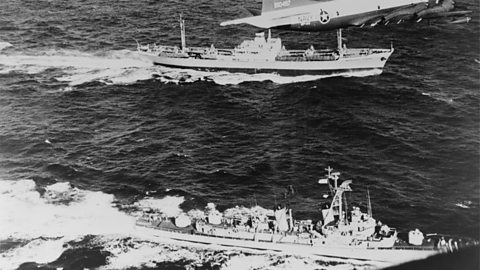
Consequences of the Cuban Missile Crisis
- The Soviets removed their missiles from Cuba.
- America promised that they would not invade Cuba.
- America secretly removed their missiles from Turkey in 1963.
- A telephone hot line was set up between Washington DC and Moscow, to enable direct communication between the leaders of America and Russia. The intention was to avoid the brinkmanshipTwo sides standing up to each other and trying to intimidate and threaten their opponent. This increased tension in Cuba as neither side wanted to be seen to have given in to the demands of the other. that had taken both sides so close to war.
- A Partial Nuclear Test Ban Treaty was agreed in 1963, which aimed to reduce some of the pressure on the arms race. This banned the testing of all nuclear weapons above ground. Tests were sometimes being used to demonstrate military power, so limiting tests was a further attempt to reduce tension.
- Other leading communist party members in Russia were unhappy with Khrushchev’s handling of the crisis. There was a feeling that Russia had been forced to back down and the crisis had embarrassed them. Khrushchev was forcibly removed from power within two years of the Cuban Missile Crisis.
Game - after the Crisis
Play a History Detectives mission exploring whether the USA or the USSR came out of the Cuban Missile Crisis in a stronger military position.
You can also play the full game.
Test your knowledge
History Detectives game. gameHistory Detectives game
Analyse and evaluate evidence to uncover some of history’s burning questions in this game

More on The Cold War
Find out more by working through a topic
- count4 of 4

- count1 of 4

- count2 of 4
